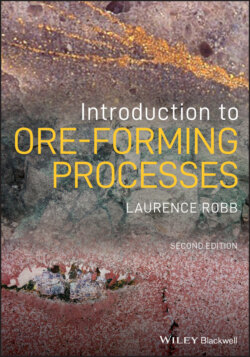Читать книгу Introduction to Ore-Forming Processes - Laurence Robb - Страница 17
Periodic Table of the Elements
ОглавлениеThe question of the number of elements present on Earth is a difficult one to answer. There are 94 primordial nuclides present on Earth, these being the elements that formed during nucleosynthesis of the material that makes up the solar system. Most of the element compilations relevant to the earth sciences show 92 elements, the majority of which occur in readily detectable amounts in the Earth's crust. Figure 4 shows a periodic table in which these elements are presented in ascending atomic number and also categorized into groupings that are relevant to metallogenesis. There are in fact as many as 118 elements known to man, but those with atomic numbers greater than 92 (U: uranium) either occur in vanishingly small amounts as unstable isotopes that are the products of various natural radioactive decay reactions, or are synthetically created in nuclear reactors. The heaviest known element, originally called ununoctium (Uuo, atomic number 118), was only fleetingly detected in a nuclear reactor – its existence has now been confirmed and officially named “oganesson” (Symbol Og) after the Russian nuclear physicist, Yuri Oganessian. Some of the heavy, unstable elements are, however, manufactured synthetically and serve a variety of uses. Plutonium (Pu, atomic number 94), for example, is manufactured in fast breeder reactors and is used as a nuclear fuel and in weapons manufacture. Americium (Am, atomic number 95) is also extracted from spent reactor fuel and is widely used as the active agent in smoke detectors.
Figure 4 Periodic table showing the elements with atomic numbers from 1 to 92; classified on the basis of their rock and mineral associations.
Of the 92 elements shown in Figure 4, almost all have some use in our modern, technologically‐driven societies. Some of the elements (iron and aluminum) are required in copious quantities as raw materials for the manufacture of vehicles and in construction, whereas others (the rare earth elements, for example) are needed in very much smaller amounts for use in the alloys and electronics industries. Only two elements appear at the present time to have little or no commercial use at all (Figure 4). These are francium (Fr, atomic number 87), and protactinium (Pa, atomic number 91). Francium is radioactive and so short‐lived that only some 20–30 g exists in the entire Earth's crust at any one time! Astatine (At, atomic number 85) is another very unstable element that exists in vanishingly small amounts in the crust as a decay chain by‐product or is manufactured synthetically. Astatine has been manufactured in particle accelerators and is occasionally used in various nuclear medical applications.
The useful elements can be subdivided in a number of different ways. Most of the elements can be classified as metals (Figure 4), with a smaller fraction being non‐metals. The elements B, Si, As, Se, Te, and At have intermediate properties and are referred to as metalloids. Another classification of elements, attributed to the pioneering geochemist Goldschmidt, is based on their rock associations and forms the basis for distinguishing between lithophile (associated with silicates and concentrated in the crust), chalcophile (associated with sulfides), siderophile (occur as the native metal and concentrated in the core), and atmophile (occur as gases in the atmosphere) elements. It is also useful to consider elements in terms of their ore mineral associations, with some preferentially occurring as sulfides and others as oxides (see Figure 4). Some elements have properties that enable them to be classified in more than one way – iron is a good example, in that it occurs readily as both an oxide and sulfide.
